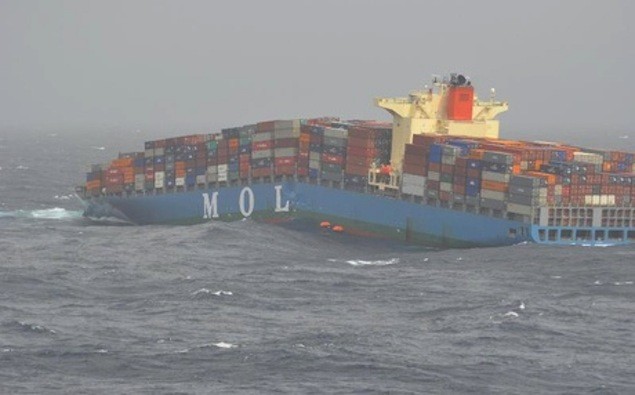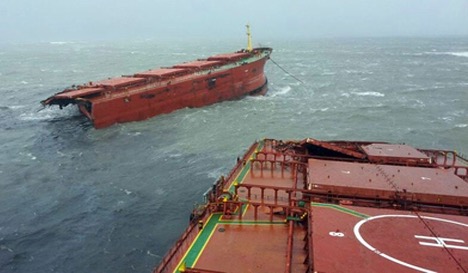The structure of a ship is subject to strain during loading and bad weather conditions. The strain or load likely to be encountered by the ship’s structure constitutes perhaps one of the most formidable problems faced by ship officers during cargo operations.
The two main types of cargo loads that are considered when loading a ship are load density and stack weight. Both of these are important to consider when planning to load cargo on a ship because they both can cause a ship’s structures to buckle.
However, it is important to note that the two are not the same although both are caused by excessive load acting on the ship deck plating.
The increasing size of ships, together with more powerful engines that create the potential for the generation of larger dynamic forces on ships should therefore serve as a reminder to the shipping industry that “Bigger ships create bigger problems”.
For example on a typical 2020, Algeciras class container ship. which has a capacity of just under 24,000 TEU, with a length of 400m and a beam of 61m, water flowing over the deck, known as ‘green water loading’, could cause high impulsive loading on container stacks and potentially trigger a collapse.1
Recent incidents in the industry that were the results of the failure of ship structures are typical examples of how super-sized ships can create super-sized problems.

So what are Load Density and Stack Weight and how do they differ from each other?
What is Load Density?
In the context of dry bulk cargo loading, the term “load density” refers to the maximum amount of weight that can be loaded safely on a unit area. In the metric system, it is expressed as tonnes per square meter (t/m2), and the higher the load density, the more weight a given tank top area is capable of withstanding without buckling.
Exceeding the maximum permissible cargo load in any of the holds of a ship will lead to overstressing of the local structure and will induce greater stresses in the double bottom, transverse bulkheads, hatch coamings, hatch covers, mainframes and associated brackets of individual cargo holds.
Load density is, therefore, an important aspect of cargo planning as proper knowledge of it ensures, that strains induced by unequal and inappropriate loading are avoided.
Consequently, the load density of the tank top should never be exceeded. The load density of various decks of a ship is usually provided in the vessel’s stability booklet and capacity plans.
Several factors affect load density- the most important being the properties of the cargo itself, such as its weight, stowage factor, shape, and compressibility. Heavier, more compact, and less-compressible cargo have a higher load density than lighter, less-compact, and more-compressible cargo.
The type of vessel and how it is loaded also affect the load density. For example, container ships can hold more cargo per cubic meter than dry bulk carriers. Finally, environmental conditions, such as the waves and wind, can affect the load density.

What is Stack Weight?
The stack weight is the maximum weight that can be borne by the deck, hatch covers, or tanktop at the corners of a bottom slot near the cell guide. The weight of a container is distributed over the four corner fittings and the entire area occupied by the container. It is also the total weight of all the cargo stacked on top of one another.
This weight must be evenly spread across the entire stack, and it is important to make sure the stack doesn’t exceed the load limit for the area where it will be stowed.
A vessel’s container stowage plan will often state limiting weights (container plus cargo) for each stack and sometimes each container position within a stack. These limits will normally take into account loading constraints on securing systems, fittings, decks, and on the containers themselves
On a container ship, the stack weight is the total weight of all containers and their contents in the tiers of a specific stack added together. The maximum permissible stack weight for each stack is specified in the ship’s cargo securing manual. Deck stack collapses are common in bays where the stack weight is exceeded.
Furthermore, the distribution of weights in a container stack has a direct impact on a vessel’s stability. The cargo securing manual specifies a maximum allowable GM for the vessel to avoid excessively short rolling periods and high accelerations.
To avoid overloading lashing and securing gear, it is critical to get the GM within the correct range before embarking on a voyage.
According to shipping container stacking regulations, containers may be stacked up to nine high, depending on the maximum stack load of the lowest container.
The allowable stacking mass represents the maximum superimposed load that any freight container can be subjected to and is often referred to as the stacking capability or stack height (when converted to a number of freight containers)2
IMO/ILO/UNECE. Code of Practice for Packing of Cargo Transport Units (CTU Code).
The stack weight can be found on the CSC plate of the container and the plan. The CSC plate is a metal plate that is affixed to the top front corner of a container. The plan is a blueprint of the vessel.
The difference between load density and stack weight
The difference between load density and stack weight is an important distinction to make when transporting cargo by sea. Load density is the amount of weight that can be safely loaded per unit volume of the hold whereas stack weight is the maximum amount of weight of the containers that can be loaded on top of the containers.
Stack weight as the name suggests is a weight that can be stacked upon a container. Load Density is often associated with bulk carriers and stack weight with containers, as they are the two main types of cargo transported by sea.
Load density is the more important of the two measures. It tells you how much weight a material can hold before it fails, while stack weight just tells you how much weight is on top of a material.
Both stack weight and load density can be important factors when it comes to maritime transportation. Stack weight can be important when considering how to load a ship, while load density can be important when calculating the maximum cargo weight a ship can carry.
Some common applications of load density and stack weight calculations in maritime transportation include the following:
- Estimating the weight of container cargo that can be safely transported on a ship.
- Determining the maximum number of containers that can be safely loaded onto a ship.
- Determining the maximum weight that a bulk carrier ship can transport.
Conclusion
The difference between load density and stack weight is an important distinction to make when loading a ship. Load density is the weight of the cargo per unit of volume, while stack weight is the weight of all the cargo stacked on top of each other. By understanding the difference between these two terms, you can ensure that your ship is loaded safely and efficiently.
Referances
- R. Meade, ‘Bigger ships create bigger problems’, Lloyd’s List (informa.com), available at https://lloydslist.maritimeintelligence.informa.com/LL1136270/Bigger-ships-create-bigger-problems last accessed on 20 April 2022.
- IMO/ILO/UNECE. Code of Practice for Packing of Cargo Transport Units (CTU Code).
- Sustainable and Luxurious: Discovering Split’s Yachting Paradise – April 26, 2024
- MarineTraffic vs VesselFinder: Which Is Better Vessel Tracking Service? – February 14, 2024
- Port Costs: A Comprehensive Guide to Port Dues and Fees for Cargo Ships – February 12, 2024






Leave a Reply